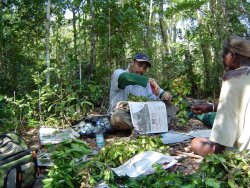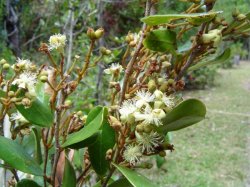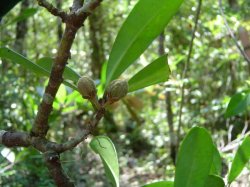Botanical Inventories at Mahabo Forest
 MBG staff, Reza Ludovic, pressing
MBG staff, Reza Ludovic, pressing
specimens in Mahabo Forest
|
Comprehensive botanical inventories are being conducted in each of the
six priority sites for littoral forest conservation with the goal of
identifying threatened species and assessing the overall species composition.
Results of inventory work will be used to evaluate patterns of species
richness, endemism, and species turnover rates along a latitudinal gradient.
For the Mahabo forest, work is done in collaboration with local people with
the purposes of prioritizing and implementing conservation strategies at the
community level.
The botanical inventory of the Mahabo Forest has resulted in a current
list that includes 288 species of higher plants belonging to 94 families,
although additional work planned for the next few years will reveal many
more. Among the small sample of species evaluated for their risk of
extinction, 14 species were assessed as Vulnerable and eight as
Endangered.
Community-Based Conservation of Mahabo’s littoral
forest
Destruction of littoral forest along the eastern coast of Madagascar
has been rapid in the last several decades. It is estimated that over
80% of original littoral forest has been lost, yet these forests contain
approximately 1,200 plant species, or 10% of Madagascar’s flora; of
these species, about half are found only in this vegetation type. One
of the largest remaining fragments of littoral forest, with an area of
3830 acres, is the Agnalazaha or Mahabo Forest, in the Commune of
Mahabo-Mananivo, in south-eastern Madagascar. Our inventories show that
the forest and its adjacent marshes, rivers and lakes support a rich
flora and fauna including several species that are locally endemic and
threatened, such as the rare and endangered gray-headed lemur
Eulemurcinereiceps. The forest also makes an important contribution
to the livelihoods and cultural life of local people through the diverse
goods and services that it provides.
Since 2003 Missouri Botanical Garden has supported a community-based
project at this site that aims to conserve the forest with its full
biodiversity complement through its sustainable use by the local community.
To achieve this goal a diverse program of activities is being implemented
that includes:
- The provision of a legal framework for the conservation of the site
through its formal designation as a new protected area;
- The conception and fair implementation of local rules concerning the
exploitation and natural resources (most particularly, timber);
- The provision of alternatives to over-exploited natural resources
(since the inception of the project over one million seedlings of
fast-growing timber species have been planted on grassland around the
forest as an alternative source of timber from native trees);
- The installation of fire breaks around parts of the forest that
are vulnerable to damage or destruction by wild fires;
- The promotion of economic actives within the local community such as
the production of specially-designed handicrafts for sale in lucrative
over-seas markets, vegetable gardening, and improved rice growing;
- The construction of a new clinic;
- The restoration of degraded forest through the plantation of seedlings
of native trees produced in village nurseries and the control of invasive
alien plants; and
- The organization of a diverse educational campaign to increase
awareness among local stakeholders of the importance of the forest, how
it is threatened, and how it can be conserved and used sustainably.
These efforts have halted the destruction and degradation of the forest
and are enabling its natural regeneration. During the project, the number
of gray-headed lemurs living within the forest, a powerful indicator of
conservation success, has risen from around 40 to 140 individuals.
This project has been supported over the years by many organizations,
including the Beneficia Foundation, Conservation International, the Liz
Claiborne and Art Ortenberg Foundation, the Mohamed bin Zayed Species
Conservation Fund, and Rio Tinto.
 Schizolaena elongata from the endemic
Schizolaena elongata from the endemic
plant family Sarcolanaceae
|
 Undescribed species of Octolepis (Thymelaeaceae)
Undescribed species of Octolepis (Thymelaeaceae)
|



